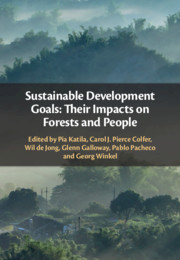14 results
Abbreviations
-
- Book:
- Sustainable Development Goals: Their Impacts on Forests and People
- Published online:
- 02 December 2019
- Print publication:
- 12 December 2019, pp xxxii-xxxiv
-
- Chapter
-
- You have access
- Open access
- HTML
- Export citation
Chapter 18 - Synergies, Trade-Offs and Contextual Conditions Shaping Impacts of the Sustainable Development Goals on Forests and People
-
-
- Book:
- Sustainable Development Goals: Their Impacts on Forests and People
- Published online:
- 02 December 2019
- Print publication:
- 12 December 2019, pp 577-600
-
- Chapter
-
- You have access
- Open access
- HTML
- Export citation
Executive Summary
-
- Book:
- Sustainable Development Goals: Their Impacts on Forests and People
- Published online:
- 02 December 2019
- Print publication:
- 12 December 2019, pp xix-xxxi
-
- Chapter
-
- You have access
- Open access
- HTML
- Export citation
Chapter 17 - SDG 17: Partnerships for the Goals – Focus on Forest Finance and Partnerships
-
-
- Book:
- Sustainable Development Goals: Their Impacts on Forests and People
- Published online:
- 02 December 2019
- Print publication:
- 12 December 2019, pp 541-576
-
- Chapter
-
- You have access
- Open access
- HTML
- Export citation
Introduction
-
-
- Book:
- Sustainable Development Goals: Their Impacts on Forests and People
- Published online:
- 02 December 2019
- Print publication:
- 12 December 2019, pp 1-16
-
- Chapter
-
- You have access
- Open access
- HTML
- Export citation
Acknowledgements
-
- Book:
- Sustainable Development Goals: Their Impacts on Forests and People
- Published online:
- 02 December 2019
- Print publication:
- 12 December 2019, pp xvii-xviii
-
- Chapter
-
- You have access
- Open access
- HTML
- Export citation
Contents
-
- Book:
- Sustainable Development Goals: Their Impacts on Forests and People
- Published online:
- 02 December 2019
- Print publication:
- 12 December 2019, pp v-vii
-
- Chapter
-
- You have access
- Open access
- HTML
- Export citation
Copyright page
-
- Book:
- Sustainable Development Goals: Their Impacts on Forests and People
- Published online:
- 02 December 2019
- Print publication:
- 12 December 2019, pp iv-iv
-
- Chapter
-
- You have access
- Open access
- HTML
- Export citation
Preface
-
- Book:
- Sustainable Development Goals: Their Impacts on Forests and People
- Published online:
- 02 December 2019
- Print publication:
- 12 December 2019, pp xv-xvi
-
- Chapter
-
- You have access
- Open access
- HTML
- Export citation
Contributors
-
- Book:
- Sustainable Development Goals: Their Impacts on Forests and People
- Published online:
- 02 December 2019
- Print publication:
- 12 December 2019, pp viii-xiv
-
- Chapter
-
- You have access
- Open access
- HTML
- Export citation
Chapter 16 - SDG 16: Peace, Justice and Strong Institutions – A Political Ecology Perspective
-
-
- Book:
- Sustainable Development Goals: Their Impacts on Forests and People
- Published online:
- 02 December 2019
- Print publication:
- 12 December 2019, pp 510-540
-
- Chapter
-
- You have access
- Open access
- HTML
- Export citation
Chapter 19 - The Impacts of the Sustainable Development Goals on Forests and People – Conclusions and the Way Forward
-
-
- Book:
- Sustainable Development Goals: Their Impacts on Forests and People
- Published online:
- 02 December 2019
- Print publication:
- 12 December 2019, pp 601-617
-
- Chapter
-
- You have access
- Open access
- HTML
- Export citation

Sustainable Development Goals: Their Impacts on Forests and People
-
- Published online:
- 02 December 2019
- Print publication:
- 12 December 2019
-
- Book
-
- You have access
- Open access
- Export citation
6 - Researching local perspectives on biodiversity in tropical landscapes: lessons from ten case studies
-
-
- Book:
- Taking Stock of Nature
- Published online:
- 06 December 2010
- Print publication:
- 18 February 2010, pp 113-141
-
- Chapter
- Export citation



